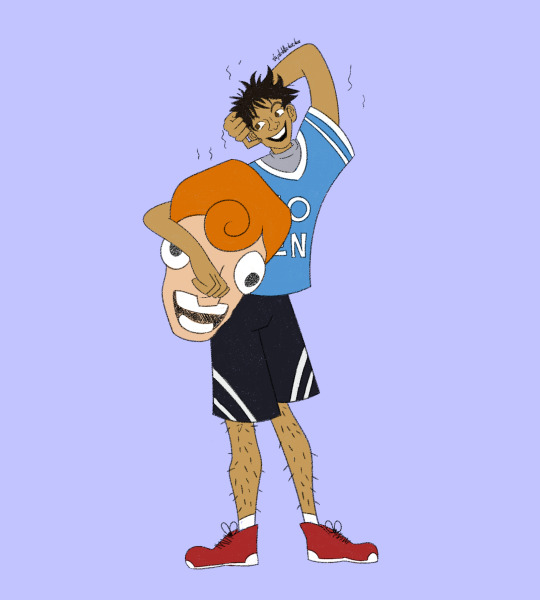#dynamic movement
Text
Here’s the climb I chuffed on before, but I finally sent it! The second move was still hard to get, but it was so satisfying to catch.
M for J 2, V4
#moniclimbs#climbing#rock climbing#bouldering#progress#me#back to moonboard content lol#sorry not sorry#girls who climb#fitness#dynamic movement#moonboard
26 notes
·
View notes
Text

#landscape#nature photography#outdoor beauty#scenic view#waterfalls#long exposure shot#artistic expression#dreamy vibes#surreal colors#mesmerizing motion#picturesque scenery#tranquil atmosphere#immersive experience#hidden gem#upstate New York#serene escape#natural wonders#vibrant hues#cascading water#dynamic movement#ethereal beauty#captivating moments#visual storytelling#breathtaking landscape#tranquil oasis#hidden treasures#magical ambiance#peaceful retreat#natural landscape#outdoor adventure
5 notes
·
View notes
Text
IT'S FINALLY FUCKING OUT AND I CAN FINALLY POST THIS!!!! (Go watch it NOW)
Thank you so much to @ohno-the-sun for hosting the map, this was the most fun first experience I've had with being a part of one :D
#nebula animates#fnaf sun#fnaf moon#fnaf dca#fnaf daycare attendant#dca map#daycare attendant#fnaf sundrop#fnaf moondrop#fun fact this. wasn't shaded until literally a couple weeks ago#sun wasn't even properly colored he just started out with a base color until i started shading#honestly with the time i spent on this (literally. less than a month) besides the shading job i did#im so fucking proud of this man#like. sure i could've been more dynamic with movements#but with what i have? i couldnt be more happier#PLUS!! in the time i finished it versus now#i've learned stuff because of it :D#i've gotten better at figuring out animating and messing with toon boom nodes#and i couldnt be happier with the progress ive made
1K notes
·
View notes
Text
Don’t do this! Instead, be an Authentic Leader today!
Leadership is essential to align your teams in a shared direction and desired goals. But, a sudden burst of soulful leadership is not always easy in the workspace.
Becoming a leader is like a dynamic movement intervention. It is similar to understanding the weak nodes behind motor impairment and learning how to change those nodes. Leadership courses work similarly.
This article Identifies some of the fundamentals of being a leader that you do NOT want to do. Keep reading if you want to move toward effortless management.
Do NOT focus on stress and reckless change around you!
Don’t be overburdened nor feel like a victim of stress with the reckless change around you. Good leaders bring a centered presence and manage their surroundings.
A good leadership practice is to analyze and understand the larger environment needed to make an impact.
Do NOT talk without listening first.
Listening is a superpower. Not many people truly hear. Mastering the art of listening will help you arrive at a fitting conclusion and decision. Ask yourself, “why am I talking?” Often if you are talking you are not able to explore the depth of the problem and can miss crucial information in understanding and making decisions.
Wise decision-making made from good listening is a quality of authentic leaders.
Do NOT be problem-oriented, look for solutions.
It is easier to focus on problems and blame others for the situation, but authentic leaders have the power to change situations. They own their mistakes and strive to correct them.
Shift your attention to the solution instead of the problem; learn to improvise.
Do NOT be silent at the wrong time.
Listening is great but talking is often needed to calm the waters and direct employees to be functional, especially during demanding times. Taking time to talk in-person will help you connect and engage others, and know better how to bring about a change.
Do NOT play small. Think of yourself as a leader.
Being an authentic leader starts with thinking about yourself as a leader. You cannot call yourself a leader until you behave like a leader and empowers yourself to solve problems.
Visualize yourself being clear, understanding and directive. An authentic leader has a good balance between compassion and wisdom.
Conclusion
Although it may be daunting, with some introspection you can be a powerful leader. FInd authentic leadership training that will develop your dynamic movements and interventions. Follow daily habits to build your new skills.
0 notes
Text


@cyberpunkcatgirl ♡
#catgirl dreams#ultrakill#celeste#t4t#kinda low lvl meme but holy fuck i love the idea of this dynamic#both games reward very high skill movement and have an insane amount of depth in their gameplay that is easy to get into and insanely#difficult to master#also both of us love infodumping to each other abt our respective game i love it i love it i love it
1K notes
·
View notes
Text

Baseball Narrator !!!
this idea came from the amazing @ /squarratorsideblog and I had to draw Wally in his own baseball outfit-
find the original idea here
#I love how dynamic baseball player movements are#it's really good to train with#Wally would probably be a pain to play against-#tsp#tsp narrator#narratorverse#tspud#narrator#the narrator tsp#the stanley parable narrator#narrator playing baseball#doodles
150 notes
·
View notes
Text

"Don't let this city swallow you up. And if it does, make sure it remembers you."
@commander-sarahs-art has done it YET AGAIN with this absolutely GORGEOUS piece of everyone's favorite merc. I have said it before and I will say it again, if you have not commissioned her you are absolutely missing out
#cyberpunk 2077#v cyberpunk#fem v friday#fem v cyberpunk#vcore#valerie vios#art: v#i seriously cannot get enough of sarah's work she always kills it#i'm FLOORED with this honestly it's one of my favorite comms ever I think#like the MOVEMENT i said to use the ref but make it more dynamic and fluid and SHE DID!!!!!!!#night city's personal jesus everyone you will Look At Her
91 notes
·
View notes
Text

Escape from Reality
#dynamic#portrait#photography#blackandwhite#bw#toned#sepia#running#escape#books#book#dreamer#daydreaming#female#nature#happy#enjoy#joyful#motion#movement#action
257 notes
·
View notes
Photo






teens who would kill you with hammers + bonus hermie the unworthy
#dungeons and daddies#normal oak#taylor swift#lincoln li wilson#scary marlowe#hermie the unworthy#dndads#i've been having a lot of fun with more dynamic shapes and movements and less realistic proportions#cuz it's fun :-)#slydiddledeeart#dndadsart
442 notes
·
View notes
Text
Pretty behind on posting vids, but here’s another fun climb I did in Bishop. It took a good amount of tries to latch the crux move and move off with a three finger drag, but it felt sooo good once I got it.
Perfectly Chicken, V5
#moniclimbs#climbing#rock climbing#bouldering#progress#me#outdoor climbing#bishop#dynamic movement#perfectly chicken
10 notes
·
View notes
Text








I don't even go here, but I needed to make a gif set for myself, because my god I am going ballistic over this.
#honkai star rail#hsr#acheron#black swan#acheswan#this is purely self indulged btw#i am NOT KIDDING when i say that this short has been stuck in my head for the entire day#i swear dance scenes as a way to communicate a relationship/characterization is my goddamn weakness#and it's a TANGO#with GIRLS#the way you can feel the dynamic shift#the way the mood is conveyed through the color palette and their movements#the way you can see everything you need to see from their dance#it's just a dance#but it's so clearly so much more#UGH#wanna do another 2 sets with all the color palettes#i am so gay
46 notes
·
View notes
Text
This survey of why parents are estranged from their adult children is such an interesting illustration of how neurobigotry functions in society and interpersonal relationships. People accuse their estranged family members of being Mad/neurodivergent, because Madness is synonymous with being at fault in a relationship. It's considered inherently Reasonable and Justified to cut ties with a Mad/neurodivergent person -- especially an untreated-by-choice Mad/neurodivergent person -- because to be Mad/neurodivergent is to be inherently wrong, inherently unreasonable, inherently burdensome, inherently the one who is not abiding by the social compact.
Or as one of my friends put it, "Mental illness exists as a sociopolitical concept of ontological wrongness."
One of the pervasively enduring aspects of neurobigotry is that people who have been abused by neurobigotry will, instead of rejecting neurobigotry, simply accept it and turn it around on their abusers. People think they're really onto something with "No, it is my abusive parents who are mentally ill and need therapy" or "No, it is the people in power who are mentally defective" or "Racism/capitalism/bigotry are the real mental illness!"
But you can't dismantle the master's house with the master's tools. Pathologizing your parents doesn't correct the power imbalance of being pathologized by them, and using pathologization as a way to convey wrongness is still reifying pathologization and neurobigotry.
The context of family estrangement reminds me of this thought process I started about the construction of "cults." When the anti-cult movement began, it was centered on family members of people who'd joined new religious movements. The premise that people who joined religious groups their families didn't approve of were victims of "cult brainwashing" who needed to be "rescued" and "deprogrammed" (against their will, of course) was a tool of controlling families trying to deny their (usually) adult children's right to freedom of religion and general life choices. The idea that "cults" caused family estrangement was an integral aspect of the moral panic around them.
But over the decades, the stigma on "cults" has shifted. The contemporary anti-cult movement is fueled by people who grew up in abusive religious communities and chose to leave. It's applied as often to older, larger, established religious groups as it is to newer, smaller ones. While the original anti-cult movement largely centered on parents trying to control their adult children, the newer anti-cult movement largely centers on adults who've broken away from their parents' control.
Except. Except. It still uses the pathologization framework established in the 1970s. It's still a reversal -- No, it is you, the parents, the church, the authority, who are the Mentally Ill, the cult, the deviant, the ones in need of being fixed -- rather than a rejection or reframing: Actually, young people should be free to choose their own path in life.
It's not only applied in relationships between parents and children -- it's even more commonly invoked in breakups between former friends or partners. People feel the need to establish which party was Mentally Ill and Needed Therapy as a proxy for which party was At Fault in the breakup. In reality, breaking up doesn't necessarily mean either party was At Fault, but it's more socially acceptable to say "We had to break up because he's Mentally Ill and Refused To Get Help" rather than "We just didn't get along." Discussions of bad and badly-ended relationships are just constant rounds of uno reverse allegations of Madness/neurodivergence.
One of my least favorite examples is trying to "rebut" the neuromisogynistic trope of "Women are crazy" with "Men cause women to become crazy."
Why are you validating "Women are crazy" by trying to "explain" it? Why are you accepting the premise that "crazy" is a bad thing? Why are you reifying the idea that being "crazy" has to be "caused" by something "bad"?
If a man says "I broke up with my ex-girlfriend because she's crazy!" why validate the neuromisogyny with "No, you're crazy!" or "You must have made her crazy!" instead of challenging it with "What's wrong with being 'crazy'? What does that have to do with anything?"
If someone says "I stopped speaking to my child because they refused to seek therapy," why validate the neurobigotry with "You're the one who needs therapy!" instead of challenging it with "Why is their choice whether or not to seek therapy any of your business?"
#neurobigotry#neuromisogyny#mad liberation#ableism#antipsych#anti psych#anti cult movement#ontological wrongness#family dynamics
42 notes
·
View notes
Photo

The Bridge of Sighs, 1903-1904. John Singer Sargent. Watercolor and graphite on paper.
#john singer sargent#art#watercolor#graphite#pencil#peinture#pittura#pintura#malarie#energy#dynamic#movement
272 notes
·
View notes
Text

referenced springtime by claude monet!
happy (belated) birthday to sebek zigvolt ⚡️💕
#glory art#twisted wonderland#twst sebek#twisted wonderland sebek#sebek zigvolt#twst#i wish i captured the dynamic movement of the lady bending down in the pocture more but this was kind of a quick piece so i didnt go back#to fix it and now im a little sad#hhhhahhhhhhhhhhhhh#twstファンアート
217 notes
·
View notes
Text












gankutsuou + incest as the meaning of the gothic novel - ruth perry
#gankutsuou#gankutsuou: the count of monte cristo#despite being an adaptation of a dumas' novel you can't ignore the japanese social context in which gankutsuou was made#as a response to the economic recession of the late 80/90s + how many young people had their futures stolen by the preceding generation#while growing up having to navigate through society's indifference towards them#that's why the anime decided to focus on the younger generation. eugenie's outfits being from the 60s are emblematic of this:#a decade in which the rise of the student movement/protests/rebellions were happening all over japan#gankutsuou addresses these themes (and the dynamics within the family unit - of institutions being parasitic upon the youth)#by adhering to the gothic paradigm - thus being a contemporary gothic piece#anyway... love how this episode is filled with birth imagery! the juxtaposition of the maternal body as womb-tomb#the “malevolent womb” as barbara creed describes
25 notes
·
View notes